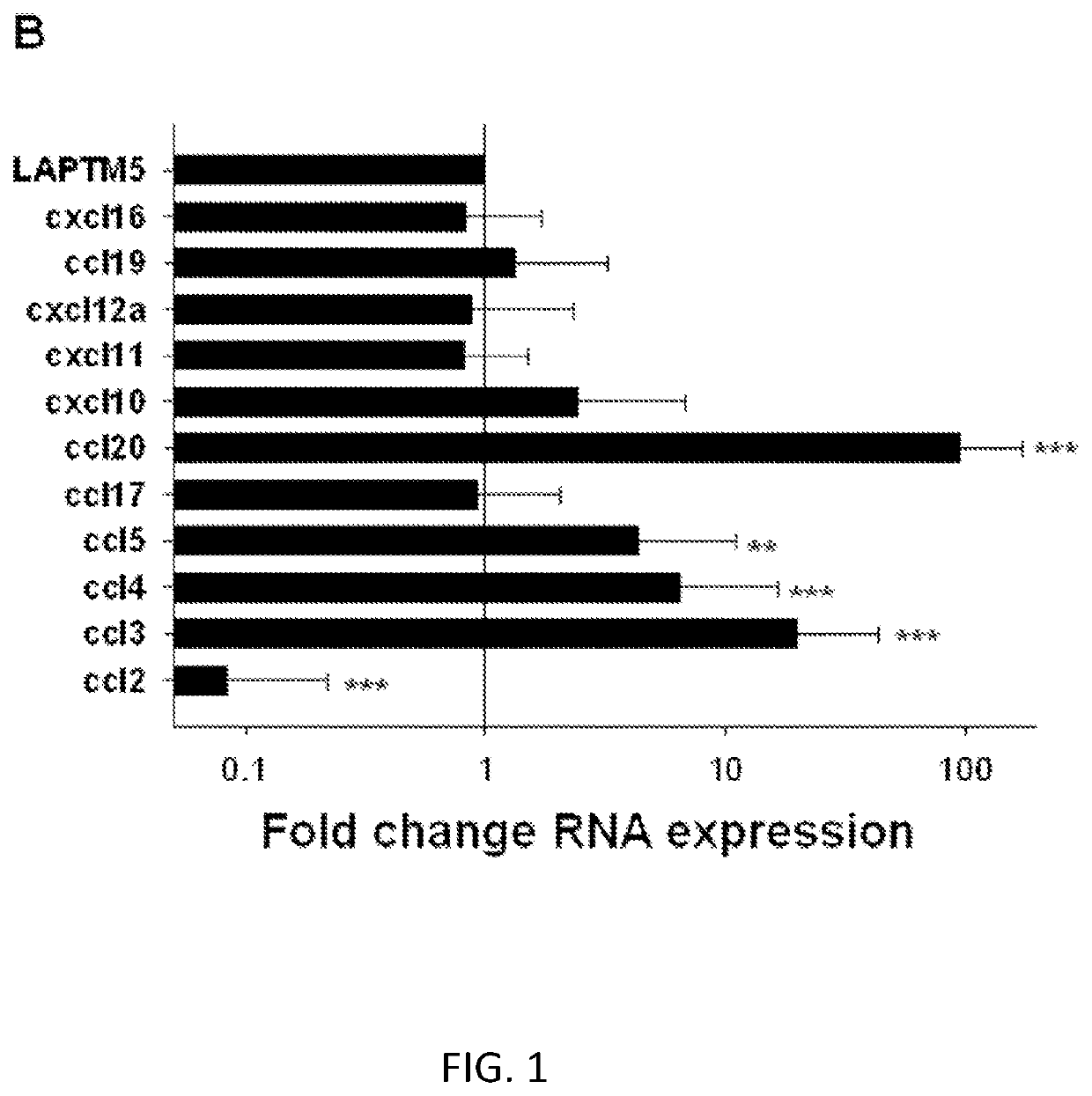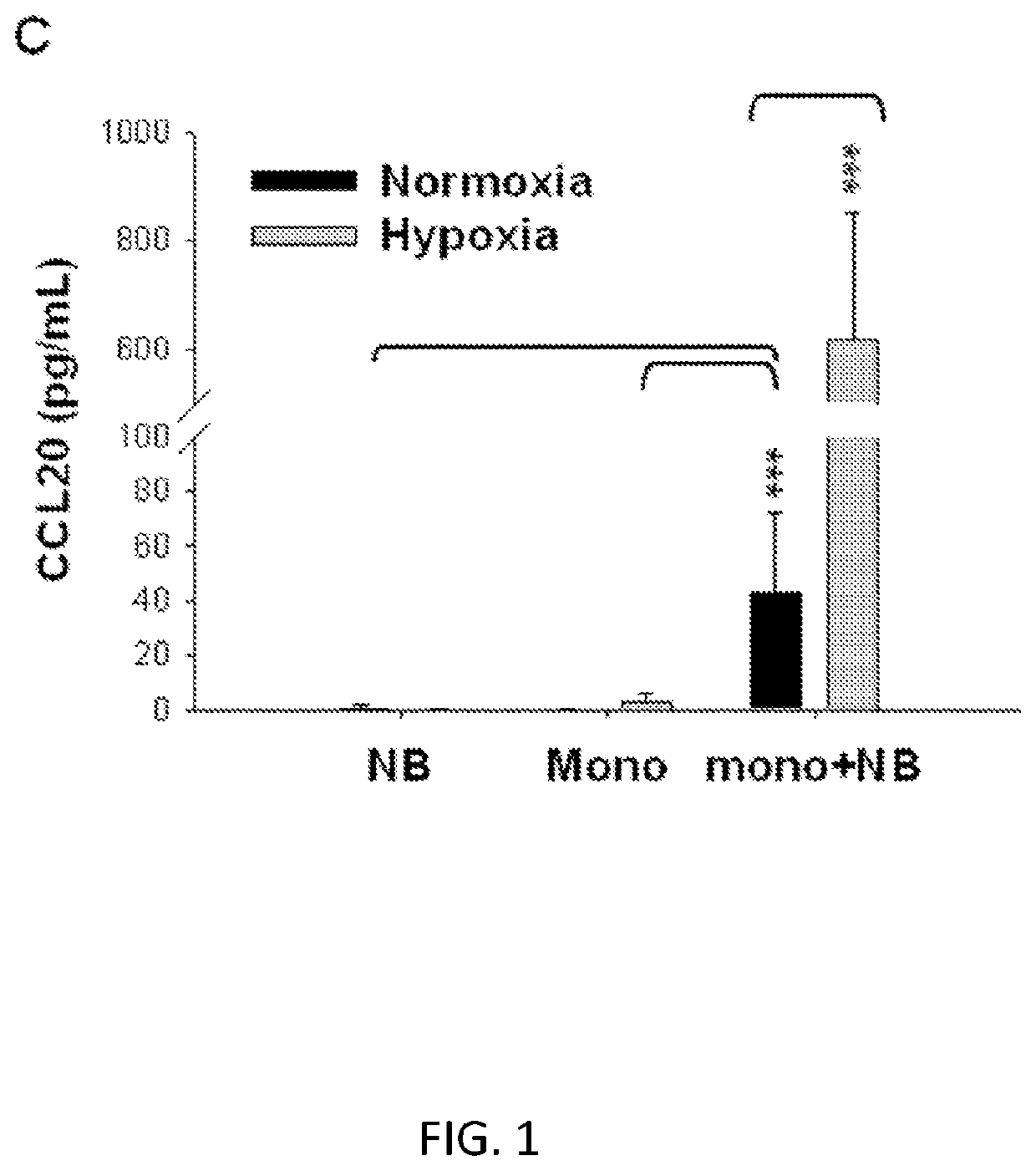Targeting the tumor microenvironment using manipulated nkt cells
a tumor microenvironment and nkt cell technology, applied in the field of biological, cell biology, immunotherapy, medicine, can solve the problems of insufficient tumor eradication, inconclusive phase i/ii clinical trials beyond the demonstration of safety, and failure of artificial car molecules to fully activate t cells
- Summary
- Abstract
- Description
- Claims
- Application Information
AI Technical Summary
Benefits of technology
Problems solved by technology
Method used
Image
Examples
example 1
Tumor-Associated Macrophages Suffocate NKT Cells: An Immune Escape Mechanism and a Target for Therapy
[0110]Vα24-invariant Natural Killer T cells (NKTs) inhibit tumor growth via targeting tumor-associated macrophages (TAMs). Tumor progression therefore requires that TAMs evade NKT-cell activity via yet unknown mechanism. In embodiments, there is a subset of cells in neuroblastoma (NB) cell lines and primary tumors express membrane-bound (mb)TNFα. These pro-inflammatory tumor cells induce production of the chemokine CCL20 from TAMs via activation of the NF-kB signaling pathway, an effect that is amplified in hypoxia. Flow cytometry analyses of human primary NB tumors revealed selective accumulation of CCL20 in TAMs. Neutralization of the chemokine inhibited in vitro migration of NKTs toward tumor-conditioned hypoxic monocytes and in vivo localization to NB grafts in humanized NOD / SCID / IL2rgamma(null) (hu-NSG) mice. Hypoxia impairs NKT-cell viability and function so that NKT-cell traff...
example 2
Contact with NB Cells and Hypdxia Synergistically Induce CCL20 in Human Monocytes
[0111]To explain the observed co-localization of NKTs with TAMs in primary human NB (Song et al., 2009), it was considered that TAMs upon the influence of tumor cells and / or hypoxic environment actively chemoattract NKTs. To further characterize this, the inventors performed an in vitro migration experiment using dual-chamber wells separated by 5 μM pore membrane. Human ex vivo expanded NKTs were added to the upper chambers and allowed to migrate for 3 h into the lower wells, which contained CHLA-255 NB cells, freshly isolated (negative selection) human monocytes from peripheral blood, or 1:1 mixture of NB cells and monocytes. Before adding NKTs, the plates with NB cells and monocytes were incubated in normoxic (20% O2) or hypoxic (1% O2) conditions for 48 h. Consistent with previous observations, NB cells were chemoattractive for NKTs in normoxic conditions (Metelitsa et al., 2004). Surprisingly, NKTce...
example 3
CCL20 is Required for NKT-Cell Migration Toward Hypoxic NB / Monocyte Culture and NB Xenografts in Hu-NSG Mice
[0114]CCL20 has been reported to be one of the most potent chemokines for human NKTs (Kim et al., 2002; Thomas et al., 2003). The analysis confirms that the majority of primary NKTs from peripheral blood express CCR6, the only receptor for CCL20. Moreover, CCR6 expression is preserved in ex vivo expanded NKTs (FIG. 8A). To determine the requirement of CCL20 / CCR6 axis for the observed enhanced migration of NKTs toward the coculture of NB cells with monocytes in hypoxia (FIG. 1A), the in vitro migration study was repeated in the presence of chemokine-neutralizing mAbs. Consistent with previous reports, anti-CCL2 mAb effectively inhibited NKT-cell migration to NB or NB+monocytes co-culture under normoxia (Metelitsa et al., 2004), but not under hypoxia. Only anti-CCL20 neutralizing mAb strongly inhibited NKT-cell migration in hypoxia (FIG. 2A).
[0115]To examine the relative contrib...
PUM
 Login to View More
Login to View More Abstract
Description
Claims
Application Information
 Login to View More
Login to View More - Generate Ideas
- Intellectual Property
- Life Sciences
- Materials
- Tech Scout
- Unparalleled Data Quality
- Higher Quality Content
- 60% Fewer Hallucinations
Browse by: Latest US Patents, China's latest patents, Technical Efficacy Thesaurus, Application Domain, Technology Topic, Popular Technical Reports.
© 2025 PatSnap. All rights reserved.Legal|Privacy policy|Modern Slavery Act Transparency Statement|Sitemap|About US| Contact US: help@patsnap.com



